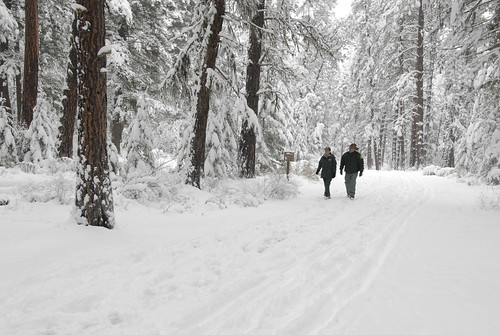
A member of the Geronimo Interagency Hotshot Crew, Department of the Interior (DOI) Indian Affairs (IA) Bureau of Indian Affairs (BIA) San Carlos Agency in Arizona; on assignment. The combined effects of droughts and insects may lead to a pulse of tree mortality that increases the potential for intense fires. USDA Photo by Lance Cheung.
The climate statistics for the first month of 2014 have been impressive. Extreme weather has lashed the United States from Alaska to Florida with record warmth, cold, dry and wet conditions all at the same time. The National Climatic Data Center reports that January of 2014 was the driest January on record for New Mexico, 2nd driest for Arizona and 3rd driest for California. January 2014 was also in the top ten of coldest Januaries on record for much of the upper Midwest.
Extreme drought conditions in the western U.S. are dramatically impacting water supplies critical to agriculture and elevating fire risk across our National Forests. Across the continent frequent cold waves have repeatedly threatened winter crops across the Southeast while frost depths reaching several feet will impact springtime planting across the Midwest. This kind of winter gets everyone talking about the weather. It brings to mind the quote “Everybody talks about the weather, but nobody does anything about it,” often attributed to Mark Twain (but apparently said by a friend).
What can we do about the weather? Not much directly, but we can plan and prepare for the worst and try our best to anticipate what is coming through forecasts. Our best climate science indicates that extreme weather is something we should get used to and learn how to work with. America’s agricultural systems and vast and precious natural resources are intimately tied to weather and climate and will need to further adapt to these extremes. This is where the newly created effort of organizing USDA resources and partners into Regional Climate Hubs plays a role, supporting farmers, ranchers and resource managers’ efforts to better manage risk in a changing climate.
There is a secret weapon in this effort, one that is a uniquely American invention. This weapon is equipped with 100 years’ experience in supporting agriculture and natural resources management through climate extremes like the Dust Bowl of the 1930’s all the way up to the Midwest floods of the early 1990’s and recent west-wide drought of the past decade. The Smith-Lever Act, signed into law by President Woodrow Wilson 100 years ago this year, created the U.S. Cooperative Extension System, a distributed network of local level experts connected to each state’s land grant university that work to connect science and decision making. This translates to a local level expert in almost every county that anyone can to turn to for ‘useful, practical and research based information’. Farmers, ranchers and resource managers will undoubtedly need new science and technology to adapt to a changing climate, but they will also simply need someone they trust of whom they can ask questions and learn about new opportunities…an ‘honest broker’ of cutting edge, research based information. Extension Agents and Specialists have served in this role for 100 years and as a key part of the USDA Regional Climate Hub effort are ready to help their clientele meet the emerging challenges of a changing climate.
I have spent the last decade in Arizona as an Extension Specialist working solely on climate issues and know the challenges that weather extremes from droughts to floods can pose to producers and resource managers. We will certainly still continue to talk about the weather on a regular basis, but our conversations in Extension and through the Hubs will also turn to what we can do about it as well.

Two Forest Service rangers walk through the snow covered paths at Lolo National Forest in Montana on November 22, 2007. Lolo National Forest is located in west central Montana and encompasses two million acres. USDA photo.
No comments:
Post a Comment